By Brandes Elitch
All art and images courtesy and copyright Francois del Cloche
One of the joys of attending Retromobile (see Art and Retromobile) is that it’s not just a collection of cars, it’s a multimedia experience. There is a whole section of the hall dedicated to artists, sculptors, model-makers, dioramas, jewelry, posters, plaques, automobilia, photographs, mascots, racing trophies, and more. When I first started attending this show, around twenty years ago, it was pretty low-key. Today, there has been enormous price appreciation in the cars themselves, and by association, with the collectibles that seem to inevitably accompany them. I cannot think of a single “car guy” I know whose home does not have a few prints, posters, drawings, or photos on the wall reflecting their passion. The marvelous thing about art is that each piece is original and unique. Art is personal, very personal.
You may want something that celebrates your favorite marque, or driver, or venue. Another person, who collects the same cars that you have in your garage, will find that an entirely different piece of art speaks to him, or her. Some people will focus on one particular artist, while others will focus on an overall theme. There is an infinite variety of expression here, and unlike the great cars, which are complete as they are, there is an extraordinary amount of new art coming out each year, so there is always the opportunity to be stopped dead in your tracks in front of a particular piece. It can come out of the blue, as it did to me at the AFAS show at Pebble Beach last August, when I saw Ken Ebert’s special exhibition piece featuring a 1956 Buick, which was so stunning it caused me to drop my wine glass! You just never know when a wonderful piece of art will reach up and smack you right between the eyes.
Until Peter Helck came along, automotive artists were primarily commercial illustrators, doing advertising and magazine art. I urge you to visit this site, and to read the “Memoirs, Part One,” section, which is just riveting. However, aside from Helck, and a few artists whose work appeared in Road & Track starting in the late fifties, automotive artists weren’t taken too seriously by the art community, or even so called “fine art” collectors. Yes, there was some precedent, as French impressionists depicted railway scenes in their work, and there were well known artists in the prewar period, such as Geo Ham in France and Gordon Crosby in England.
Each artist has a style that allows you to say, “I know who that is.” That doesn’t mean that the style will never change, but my sense is it will not change too much, not like Picasso, at least. If you like a particular artist, you will immediately recognize him or her without having to see the signature. One of my favorite artists exhibiting at Retromobile is Francois de la Cloche (www.fdelacloche.com). His style is unique for a few reasons. One is the fact that his medium is Faber et Castel colored pencils. Another is his sharp eye for detail, and extraordinary sense and memory of color. Another is that he typically pairs the subject with a period correct architectural background that is also highly detailed and authentic. As a totality, the combination is striking. Francois typically does an original work as a commission, and then will make a limited edition of posters as well, and I am fortunate to have a series of them at home.You cannot be an automotive artist without a strong sense of form and style, and history too. I believe that we are drawn to the cars of our youth. Francois’ father worked at SHAPE-NATO headquarters, and he attended a NATO school for dependents. He grew up in the fifties and sixties, being mesmerized by American cars of the era, which must have looked like spaceships in France at the time. He also remembers at age ten being driven in his uncle Henry’s DS 19. He has an extraordinary memory for color, and when we attended the fiftieth anniversary of the DS, he shocked me by rattling off the original factory names for each color of every car! His first collector car was acquired in 1983, found in the small ads of La Vie de l’Auto, a Simca Versailles, just like his parents had in the early 1960’s.
He met his wife, Florence, at a SIMCA club meeting – her father was the club President! In addition to the SIMCA’s, he has two FIAT 2300 Ghia coupes, a 1938 Matford, and a show quality 1964 Buick Riviera, which is a handful to drive on the narrow roads where he lives, not too far from Monet’s village of Giverny in the Vexin region north of Paris. He lives in a restored Relais, which was built in the 1800’s as a stagecoach stop, so he was able to convert the stables to garages, around the central courtyard. The back wall is a Roman ruin, so the overall effect is quite striking.
Francois studied art at the Ecole Nationale Superieure des Arts Appliques a L’Industrie et des Metiers d’Arts. He was inspired by the drawings of Paul Bracq which he saw in Automobile magazine while he was in school. It you look at this site, you will see that Bracq is a force of nature among automotive artists in Europe. Bracq has served as a mentor to him ever since. After a career in marketing at Peugeot, Francois was encouraged by his family to “do something with your pencils! And so he began to draw automobiles representative of their particular era, with extreme attention to authenticity. He was encouraged by the French artist Thierry Dubois and the editor Didier Laine. Another trademark of his work is that he will sometimes include his wife Florence, in period costume, in the picture.
I have visited Francois numerous times, and I am looking forward to showing him some of our car museums here in California when he comes here for vacation this summer. The point of all this, of course, is the art, so here is a representative selection of his work. To contact Francois, simply go to his website and follow the link. He is fluent in English too.Tel :
+33 (0)6 08 30 35 39
Email:
fdelacloche@aol.com
Website:
www.fdelacloche.com
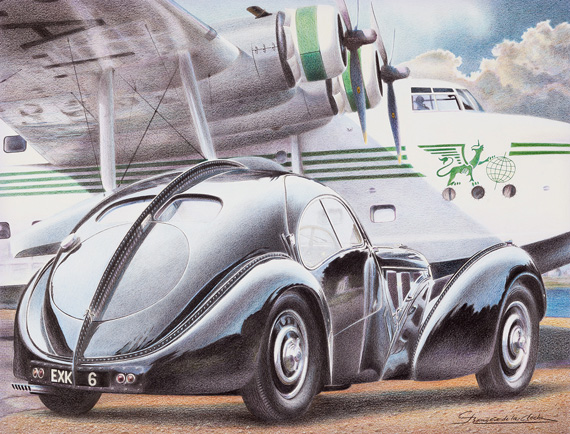
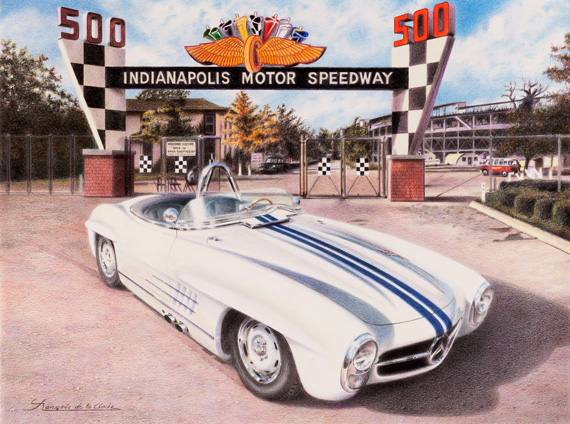
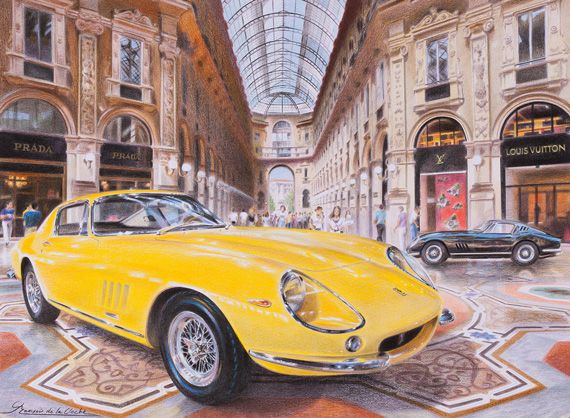
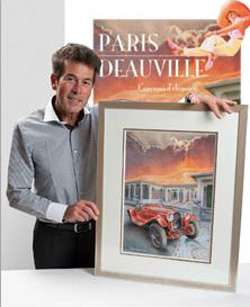
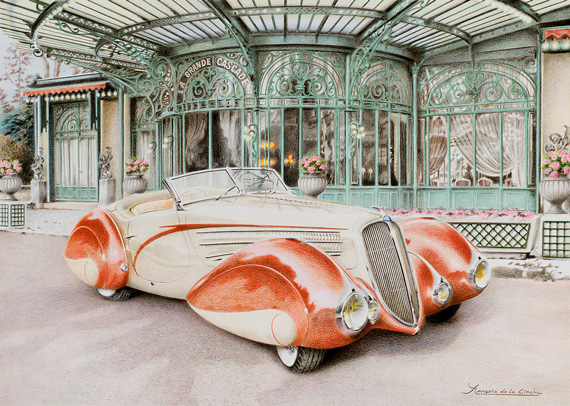
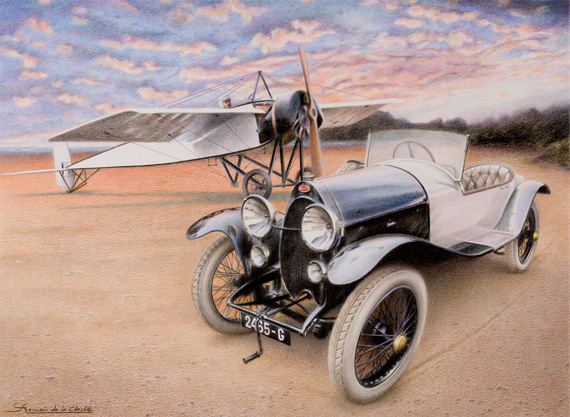
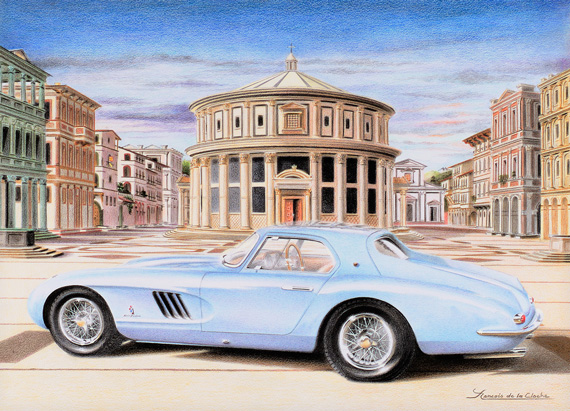
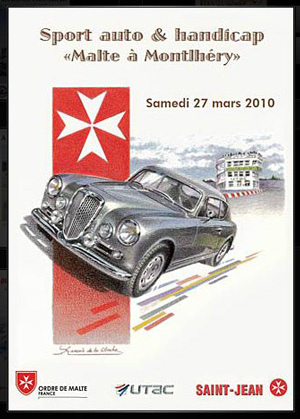

Wonderful.
I would only add that you do not mention the setting for the pair of 275 GTB’s. It is, of course, the magnificent Galleria Vittorio Emanuele ll in Milan that links the Duomo and the LaScala squares. One of the first (and largest) glass enclosed shopping arcades built in the mid 1860’s by Giuseppe Mengoni.
The beauty of the building certainly a worthy setting for one of Pininfarina’s best.